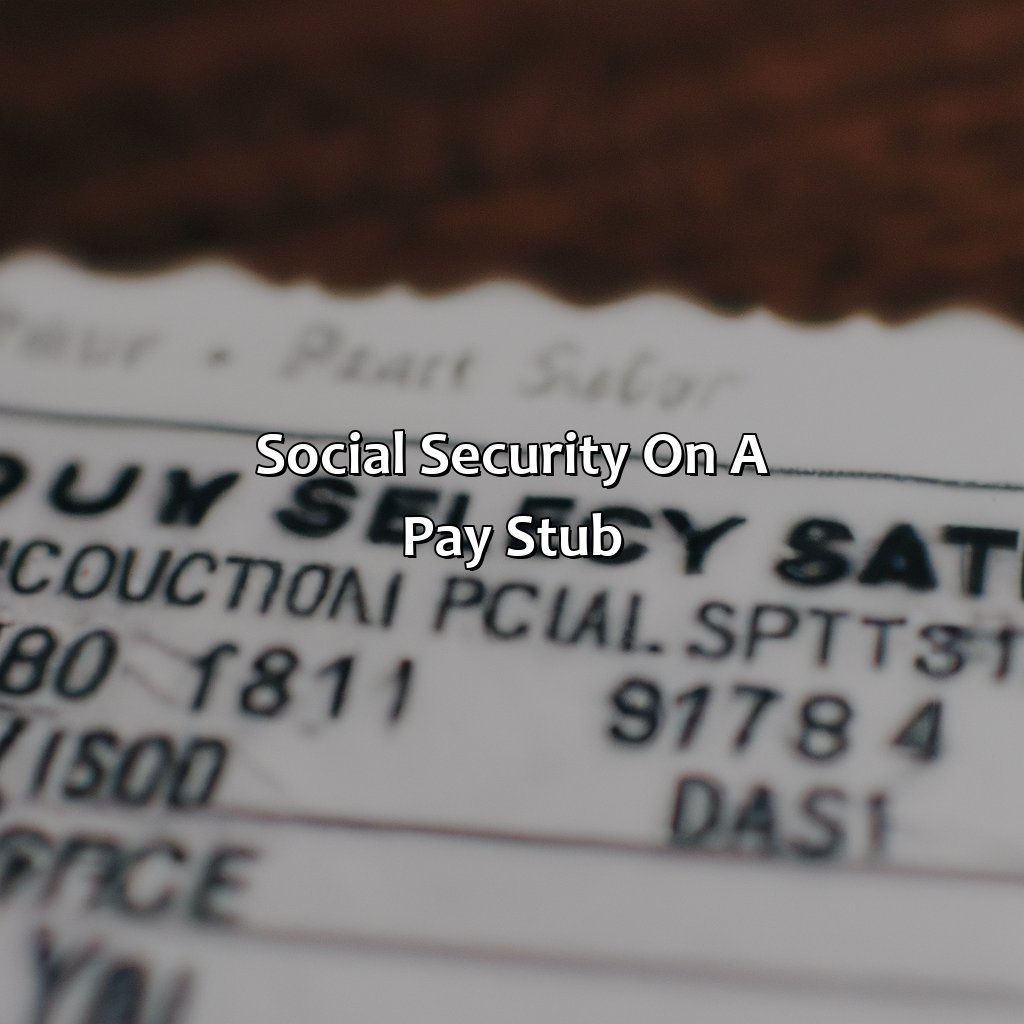What Is Social Security On Pay Stub?
Key Takeaways:
- Social security is a government program designed to provide financial security for retired and disabled workers and their families.
- Social security contributions are typically reflected on a pay stub as a deduction from an employee’s gross pay, alongside other taxes and benefits.
- Understanding social security deductions requires knowledge of how they are calculated and the current tax rate, as well as tips for managing contributions such as increasing benefits and avoiding errors.
Are you wondering what’s the purpose of the ‘social security’ line on your pay stub? Find out why it’s important and how it can help you with this guide. You’ll learn how social security works and how it impacts your financial future.
What is social security?
Social security is a national insurance program primarily designed to provide financial assistance to retirees, disabled individuals, and survivors of retirees. It is a scheme that is set up to provide income replacement when an individual retires, becomes disabled or dies. Social Security is based on the concept of social insurance, where individuals pay in a portion of their income over their working years, and the government ensures that they receive regular benefits during their retirement or disability. The contribution is also used to provide survivor benefits to the family in case of the death of the breadwinner.
Social security on a pay stub is an essential feature for employees as it ensures that they are aware of how much social security tax is being withheld from their salaries each month. The employer usually withholds a certain percentage of the employee’s income and pays the same amount on behalf of the employee to the Social Security Administration(SSA). The percentage of pay which an individual is taxed changes annually, according to the prevailing laws. The main aim of Social Security is to provide economic stability to the elderly, disabled, and survivors of deceased workers.
It is imperative to understand that social security is not a mere tax, but it is a form of income protection for people who have retired or are disabled. Social security payments depend on the average income earned by an employee during their working years, their age when they begin receiving benefits, and their social security status. Social security is a crucial aspect of financial planning for all employees and must be taken into consideration when making long term income and retirement plans.
To optimize social security funding, individuals must focus on ways to enhance their retirement savings and reduce expenses. This could be achieved by creating a budget, avoiding excessive debt, and contributing to retirement accounts. The social security program also offers an online portal for people to create an account, monitor how much they have contributed, and estimate their future benefits. Hence, it is essential to keep track of the social security contributions and plan accordingly to reap the maximum benefits during retirement.

Image credits: retiregenz.com by James Jones
Social security on a pay stub
Social security withholding on a pay stub is a government program that provides income for retirees, disabled individuals, and their families. The Social Security Administration requires employers to withhold a percentage of their employees’ wages to contribute to the program. The withholding amount varies based on the employee’s earnings and changes periodically. This is an important deduction to ensure a secure future for employees and their families in retirement. With Social Security, millions of Americans benefit from a guaranteed source of income. According to the Social Security Administration, over 65 million Americans will receive approximately $1 trillion in benefits in 2021 alone.

Image credits: retiregenz.com by Harry Jones
Understanding social security deductions
Do you need help understanding social security deductions on your pay stub? Let’s dive into it! We’ll look at how they are calculated and the current tax rate. Knowing this info can help you make sense of your pay stub and plan for the future.
How are social security deductions calculated? What is the current social security tax rate? Let’s find out!

Image credits: retiregenz.com by Adam Jones
Subheading: How are social security deductions calculated?
The mechanism behind social security deductions necessitates that a certain portion of your salary goes towards your social security benefits plan. This system was created to support people who need assistance, particularly in their old age and when they become disabled.
| Criteria | Calculation Method |
|---|---|
| Tax rate for social security | 6.2% for an employee and the same percentage is paid by the employer |
| Social security tax maximum income | $142,800 for the present year |
It is important to keep in mind that there is a maximum amount you can deduct from your paycheck towards social security taxes; as mentioned before, this ceiling changes yearly.
Social Security has secured financial well-being for people throughout America’s history. Proposed by President Franklin D Roosevelt, Social Security was signed into law on August 14, 1935.
The only social security we can count on is the tax deducted from our paychecks.
Subheading: What is the current social security tax rate?
The social security tax rate is ever-evolving, but what is the current rate? The present-day percentage of social security tax is 6.2% for both employees and employers. To be precise, it means that as an employee, 6.2% of your salary or wages will be subtracted as social security tax deductions, while your employer pays an equivalent amount in his contribution.
These standard social security rates are compulsory for individuals working under the Social Security system regardless of their age or income level. Although there may be modifications to these rates, it’s imperative to note that any changes may significantly affect millions of Americans.
While it’s clear-cut how much you pay into social security taxes every payday, understanding the more comprehensive aspects can be overwhelming. However, staying educated on such crucial details can save you a lot in the long run and set you up for future success.
According to Forbes (2018), “Social Security benefits account for approximately 38 percent of elderly income.” Thus utilizing knowledge from comprehending your paycheck stubs could aid your financial planning process and improve overall quality of life post-retirement.
Managing social security contributions is like playing a game of Jenga, one wrong move and it could all come crashing down.
Tips for managing social security contributions
Maximize your returns from social security contributions! Learn how to increase benefits and avoid mistakes. This section provides the solution you need. It has helpful tips that include subheadings on how to increase social security benefits and how to avoid errors in social security contributions.

Image credits: retiregenz.com by David Arnold
Subheading: How to increase your social security benefits
To optimize your social security retirement benefits, there are a few things you can do to increase payments for the rest of your life.
- Work and earn income for as long as possible: Your social security benefits are calculated based on the average amount of money you earn over 35 years. If you work for less than that period, those non-earning years will significantly lower your social security payouts.
- Delay claim filing as long as possible: You’re eligible to claim social security retirement benefits starting at age 62, but waiting until full retirement age (66-67, depending on birth year) or even later is a way to maximize monthly payments.
- Make more money annually: Social Security contributions cap out each year, so increasing taxable earnings can raise future payout levels.
- Work to at least full retirement age: Claiming social security before then triggers reductions in lifetime benefits and makes it challenging to reverse those lower payouts.
It’s also worth noting that delaying starting Social Security payments has some additional advantages besides significantly higher lifetime payouts. The longer you wait after becoming eligible at 62 years old, the greater your annual Cost Of Living Adjustment (COLA) increases will be once payment kicks in.
Finally, here’s an anecdote about how benefiting from maximized social security payouts affected someone in real-life.
My next-door neighbor worked part-time from home so she could take care of her children while they were young. It resulted in her missing the maximum earning-cap limit many times throughout her career journey leading up to 35 years. After learning more about maximizing Social Security payments through certain methods, she delayed claiming her benefits until reaching full retirement age and was pleased with how much higher monthly payments would be compared if she claimed them earlier.
Missing your social security contributions is like missing a step on a staircase – it may not seem like a big deal at first, but it can lead to a painful fall later on.
Subheading: Avoiding errors in social security contributions
Maintaining precise records and calculations is crucial when managing social security contributions. To avoid discrepancies, ensure the information provided on pay stubs is accurate. Cross-referencing the details with official documents aids in minimising errors during contribution submission.
Additionally, understanding the criteria for employee eligibility for social security benefits helps in determining appropriate contributions.
It is also essential to keep track of changes in regulations or standards pertaining to social security contributions to avoid non-compliance penalties. Understanding these intricacies ensures proper management of employee contributions.
According to a report published by the Social Security Administration in 2020, approximately 17% of Americans rely solely on their social security benefit as a source of income during retirement.
5 Well-Known Facts About Social Security on Pay Stub:
- ✅ Social Security is a federal program that provides retirement, disability, and survivor benefits to eligible individuals. (Source: Social Security Administration)
- ✅ Social Security taxes, also known as FICA taxes, are deducted from employees’ paychecks and matched by their employers. (Source: Internal Revenue Service)
- ✅ The Social Security tax rate is currently 6.2% for employees and 6.2% for employers, for a total of 12.4%. (Source: Social Security Administration)
- ✅ The amount of Social Security benefits received is based on an individual’s earnings history and the age at which they begin receiving benefits. (Source: Social Security Administration)
- ✅ Social Security provides important financial support to millions of Americans, but the program’s long-term sustainability is a growing concern. (Source: Forbes)
FAQs about What Is Social Security On Pay Stub?
What is Social Security on a pay stub?
Social Security is a government program that provides retirement, disability, and survivor benefits to eligible individuals.
How is Social Security calculated on a pay stub?
Social Security is a payroll tax paid by employees and employers. The current rate is 6.2% for both, up to a certain income limit. The amount withheld from an employee’s paycheck is listed as “Social Security” on their pay stub.
What if I don’t see Social Security listed on my pay stub?
If you don’t see “Social Security” listed on your pay stub, it’s possible that your employer is using a different term to refer to the payroll tax. Look for any deductions labeled as “FICA” or “OASDI.” These are also names for the Social Security payroll tax.
Can I opt out of paying Social Security on my pay stub?
No, you cannot opt out of paying Social Security taxes. It is a mandatory payroll tax paid by employees and employers in the United States.
What happens to the money deducted for Social Security on my pay stub?
The money deducted for Social Security on your pay stub goes into the Social Security Trust Fund. This fund is used to pay retirement, disability, and survivor benefits to eligible individuals.
How do I qualify for Social Security benefits?
To qualify for Social Security benefits, you must earn enough work credits through paying Social Security taxes. The number of credits needed varies depending on the type of benefit you are claiming. You must also meet other eligibility requirements, such as age, disability, or survivorship status.


